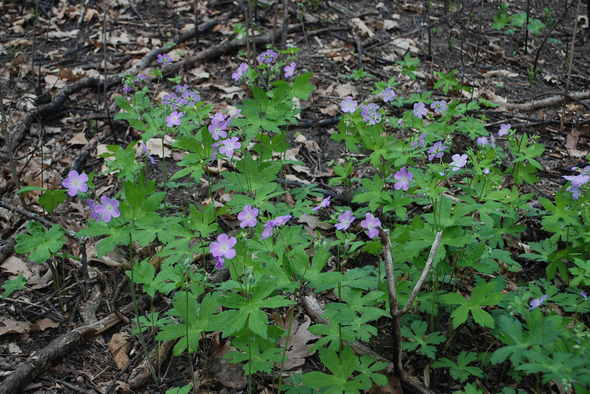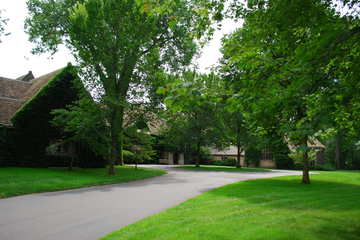Yard conversion lesson 1: Visualize your yard as you move toward nativity

Wild geranium (Geranium maculatum) may be part of your vision, if you want to create a little bit of a woodland in your yard.
Rick Meader | Contributor
So Rick, you ask, do you have a grand plan for your new yard? And, I have to admit, my grand plan right now is more of a general, misty view in the distance, and the plants that were recently placed may very well be moved as the vision become clearer, if they live.
This brings me to the point of this entry — vision. Like life, a clear vision of what you want helps you to seek it and take steps toward it, and it’s something that a lot of gardeners don’t always have. A lot of gardeners, like me on occasion, become enamored with collecting individual plants without thinking about the overall yard. I think that it’s never too late to consider what you want to have in your yard with regard to its overall look, feel and function, and work from and toward that vision as you select plants to add and plants to subtract.
To me, there are several elements to consider in visualizing what you want your yard to be. These are: Atmosphere (feel), Light, Seasons, Events (function) and Wildlife. In mixed up order, this spells WALES, which has nothing to do with anything, but it’s easier to remember. Let’s go through them in that order, remembering that all of them are important. (And I can’t really say that there is a consistent cascading priority of importance for every situation or property owner - it varies):
Wildlife - If you want to help out our feathered, furry or scaly friends, you need to make situations for them in which they want to and can live - eat, hide and procreate. This will have a profound impact on the look and feel of your property. If you only have one element, for example a bird feeder, you may get visitors, but they won’t come to stay — kind of like an unfriendly uncle’s house with great food. Short term stays at meal time are more than enough for you, but the uncle doesn’t get a lot of your time.
Atmosphere (feel) - If you want to feel cozy in your homestead, an expansive lawn with little privacy-creating shrubbery or trees between your house and your street won’t give that to you, so you might feel the need to stay inside your house more than you’d like, to get that cozy feeling. Do you want a “foggy forest”, a “morning mist meadow”, a “leafy cathedral” or some other unnecessarily quoted feeling? Achieving those feelings will also have a large impact on what plants you keep or promote and how they’re placed.

Edsel and Eleanor Ford's home landscape in Gross Pointe Shores was designed by Jens Jensen, a master at using light and vegetation (much of it native to Michigan) of varying heights to create pleasant experiences for his clients in their yards. While we don't all have 87 acres of lakefront property to play with, really visualizing what you want from your land will help you to create a pleasing setting for life on your home turf.
Rick Meader | Contributor
Light - If you want a lot of sun streaming into your house, don’t live in the middle of a forest, or plant too many shade trees near your house - especially trees generating heavy shade like maples. At the same time, if you don’t want to have a sun-baked yard, you will want to have some shade somewhere close by. But, to take it a step further, if you do want some shade, or some light, think about where you want to be along the “sun scale” - light shade, shade at some points of the day but not others, heavy shade? Your plant selection and plant placement will be strongly directed by these goals, and will in turn greatly impact the effect you get from your landscape.
Events (function) - If you want to have big lawn parties or soccer games, you’re going to need a lot of contiguous open area. Depending on the size of your lot, this will either be a dominant feature or be an outside room. If you want to have tranquil places to sit and read or visit, or places to walk and contemplate nature, you will want to create smaller spaces through abundant plantings (or by preserving more of what existing plantings you already have).
Seasons - In Michigan, the four seasons, and transitions between them, create a myriad of options for looks you can get in the same spot. It would be a good idea to consider this as you conceptualize your yard. Think, for example, if you want color through the growing season, or if you’d be content with explosions of color in spring and fall.
Are you comfortable with a dormant winter look, or do you need evergreens of some kind to take away from the whites, tans and greys of winter? How soon in the spring do you need to see color? What colors do you really want to see in the spring, summer and fall? This latter point gets toward plant selection, but it also helps you visualize what you want to see in the yard.
The seasons impact the light patterns within a single day as well. Do you like long shadows? Do you want sun shining into your bedroom in the morning to help you greet a new day, or do you want to sleep in until you’re woken by persistent kids, hopefully later than daybreak? Again, these factors will impact what you do with your yard.
As you can see, you have a lot to think about before you even start selecting plants, but if you do your homework, and look inside your mind to remember landscapes you especially enjoy, or inside colorful magazines, to get a good idea of what you want from your yard, it will help a lot to come up with a design or concept that you can follow as you move through the years.
Next week we’ll start going through some examples of looks and native plants that can help you achieve that look and support native wildlife better than non-natives do. In the meantime, blooming in our yard are non-native daisies, and hairy beardtongue. It will get better, I promise.
Rick Meader is a local landscape architect whose firm, Ecological Edge LLC, specializes in creating designs for homes, businesses and even churches that include a lot of native plants (and the wildlife they attract). You can contact him at ecologicaledgellc@yahoo.com.


Comments
kralrampton
Thu, Jun 20, 2013 : 11:30 a.m.
Beside my house there was yard which was of no use but then I cleaned it and planted some trees for natural freshness inside my house and yes it really worked. designer office furniture